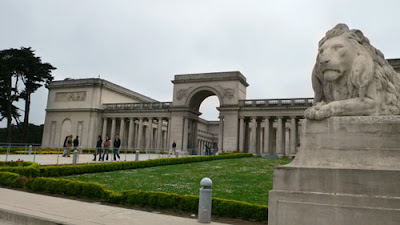The Legion of Honor in San Francisco is one of jewels of the San Francisco museum crown. Spectacular views, fabulous exhibits and stunningly beautiful landscaped grounds have delighted visitors, provided movie settings and hosted innumerable weddings.
High on the headlands above the Golden Gate—where the Pacific Ocean spills into San Francisco Bay—stands the California Palace of the Legion of Honor, the gift of Alma de Bretteville Spreckels to the city of San Francisco. Located in Lincoln Park, this unique art museum is one of the great treasures in a city that boasts many riches. The museum’s spectacular setting is made even more dramatic by the imposing French neoclassical building.
Entrance to the Legion of Honor
In 1915 Alma Spreckels fell in love with the French Pavilion at San Francisco’s Panama Pacific International Exposition. This pavilion was a replica of the Palais de la Légion d’Honneur in Paris, one of the distinguished 18th-century landmarks on the left bank of the Seine.
Outside Arch
Alma Spreckels persuaded her husband, sugar magnate Adolph B. Spreckels, to recapture the beauty of the pavilion as a new art museum for San Francisco. At the close of the 1915 exposition, the French government granted them permission to construct a permanent replica, but World War I delayed the groundbreaking for this ambitious project until 1921.
Parking Lot Art
Constructed on a remote site known as Land’s End—one of the most beautiful settings imaginable for any museum—the California Palace of the Legion of Honor was completed in 1924, and on Armistice Day of that year the doors opened to the public. In keeping with the wishes of the donors, to “honor the dead while serving the living,” it was accepted by the city of San Francisco as a museum of fine arts dedicated to the memory of the 3,600 California men who had lost their lives on the battlefields of France during World War I.
Kim Novak in Vertigo gazes at a
painting in the Legion of Honor
Architect George Applegarth’s design for the California Palace of the Legion of Honor was a three-quarter-scaled adaption of the 18th-century Parisian original, incorporating the most advanced ideas in museum construction. An assessment performed in the 1980s showed that the landmark building needed to be made seismically secure. Between March 1992 and November 1995—its seventy-first anniversary—the Legion underwent a major renovation that included seismic strengthening, building systems upgrades, restoration of historic architectural features, and an underground expansion that added 35,000 square feet. Visitor services and program facilities increased, without altering the historic façade or adversely affecting the environmental integrity of the site.
Rodin's The Thinker and Chihully Chandelier
The 1995 renovation realized a 42 percent increase in square footage, including six additional special exhibition galleries set around the pyramid skylight visible in the Legion courtyard. The glass pyramid sits atop the Rosekrans Court and special exhibition galleries located below. It is a key second focal point in a formal courtyard otherwise focused solely on Auguste Rodin’s The Thinker, as well as a light and tensile counterpoint to the heavy stone materials of the Court of Honor, lending scale and interest.

.jpg)

.jpg)
.jpg)

.jpg)






























Such a spectacular place ~ it's been far too long since I visited!
ReplyDeleteBobbie - It's always a treat - not just the art, but that amazing view!
ReplyDeleteErin